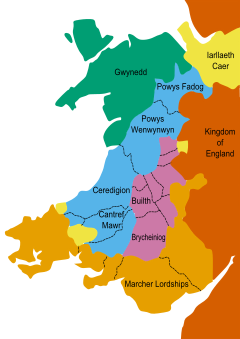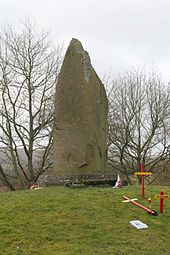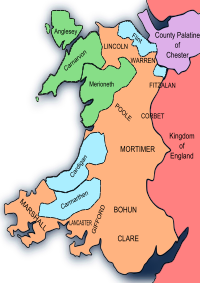Conquest of Wales by Edward I
Theconquest of Wales by Edward Itook place between 1277 and 1283. It is sometimes referred to as theEdwardian conquest of Wales,[note 1]to distinguish it from the earlier (but partial)Norman conquest of Wales.In two campaigns, in 1277 and 1282–83, respectively,Edward I of Englandfirst greatly reduced the territory ofLlywelyn ap Gruffudd( "Llywelyn the Last" ), and then completely overran it, as well as the other remaining Welsh principalities.
By the 13th century,Waleswas divided between native Welsh principalities and the territories of theAnglo-NormanMarcher lords.The leading principality wasGwynedd,whose princes had gained control of the greater part of the country, making the other remaining Welsh princes their vassals, and had taken the titlePrince of Wales.Although English monarchs had made several attempts to seize control of the native Welsh territories, it was not until Edward's war of conquest against Llywelyn, the last native prince of Wales, that this was achieved on a lasting basis.
Most of the conquered territory was retained as a royal fief, and these lands later became, by custom, the territorial endowment of the heir to the English throne with the titlePrince of Wales.The remainder would be granted to Edward's supporters as new Marcher lordships. Although the territories would not be effectively incorporated into theKingdom of Englanduntil theLaws in Wales Acts 1535–1542,Edward's conquest marked the end of Welsh independence.
Background: Wales in the High Middle Ages[edit]

Following a series of invasions beginning shortly after theirconquest of Englandin 1066, theNormansseized much of Wales and established quasi-independentMarcher lordships,owing allegiance to the English crown.[1]However, Welsh principalities such asGwynedd,PowysandDeheubarthsurvived and from the end of the 11th century, the Welsh began pushing back the Norman advance.[1]Over the following century the Welsh recovery fluctuated and the English kings, notablyHenry II,several times sought to conquer or establishsuzeraintyover the native Welsh principalities.[2]Nevertheless, by the end of the 12th century the Marcher lordships were reduced to the south and south-east of the country.[2]
The principality of Gwynedd was the dominant power in Wales in the first half of the 13th century, with Powys and Deheubarth becomingtributary states.[3]Gwynedd's princes now assumed the title "Prince of Wales".[4]But war with England in 1241 and 1245, followed by a dynastic dispute in the succession to the throne, weakened Gwynedd and allowedHenry IIIto seizePerfeddwlad(also known as the "Four Cantrefs",[5]the eastern part of the principality).[6][7]However, from 1256 a resurgent Gwynedd underLlywelyn ap Gruffudd(who became known as "Llywelyn the Last" ) resumed the war with Henry and took back Perfeddwlad.[7]By theTreaty of Montgomeryof 1267, peace was restored and, in return for doinghomageto the English king, Llywelyn was recognised as Prince of Wales and his re-conquest ofPerfeddwladwas accepted by Henry.[8][9]However, sporadic warfare between Llywelyn and some of theMarcher Lords,such asGilbert de Clare,Roger MortimerandHumphrey de Bohuncontinued.[10]
Conquest[edit]
Immediate causes of war[edit]
Henry III died in 1272 and was succeeded by his son,Edward I.Whereas Henry's ineffectiveness had led to the collapse of royal authority in England during his reign,[11]Edward was a vigorous and forceful ruler and an able military leader.[12]
In 1274, tension between Llywelyn and Edward increased whenGruffydd ap Gwenwynwynof Powys and Llywelyn's younger brotherDafydd ap Gruffydddefected to the English and sought Edward's protection.[13]The continuing conflict with the Marcher Lords, particularly over Roger Mortimer's new castle atCefnllys,and Edward's harbouring of defectors led Llewelyn to refuse Edward's demand to come toChesterin 1275 to do homage to him, as required by theTreaty of Montgomery.[14]For Edward, a further provocation came from Llywelyn's planned marriage toEleanor,daughter ofSimon de Montfort,the leader of a rebellion against the crown during the reign of Edward's father.[15]In November 1276, Edward declared war on Llywelyn.[16]However, his objective was to put down a recalcitrant vassal rather than to begin a war of conquest.[17]
Invasion of 1277[edit]
Early in 1277, before the main royal army had been mustered, Edward deployed, in south and mid-Wales, a mixture of forces comprising paid troops, some of the marcher lords' retainers and knights of the royal household. They met with considerable success as many of the native Welsh rulers, resentful of Llywelyn's overlordship, surrendered and joined the English.[17]In July 1277, Edward launched apunitive expeditioninto North Wales with his own army of 15,500—of whom 9,000 were Welshmen from the south—raised through a traditionalfeudal summons.[18]From Chester the army marched into Gwynedd, camping first atFlintand thenRhuddlanandDeganwy,most likely causing significant damage to the areas it advanced through. A fleet from theCinque portsprovided naval support.[18]
Llywelyn soon realised his position was hopeless and quickly surrendered. The campaign never came to a major battle. However, Edward decided to negotiate a settlement rather than attempt total conquest. It may be that he was running short of men and supplies by November 1277 and, in any case, complete conquest of Llywelyn's territories had not been his objective.[18]
Treaty of Aberconwy[edit]

By the Treaty of Aberconwy in November 1277, Llywelyn was left only with the western part of Gwynedd, though he was allowed to retain the title of Prince of Wales.[19]Eastern Gwynedd was split between Edward and Llywelyn's brother Dafydd, with the remainder of the lands that had been tributary to him becoming effectively Edward's.[19]
As a result of both territorial expropriation and the submission of the ruling families, Deheubarth, Powys and mid-Wales became a mixture of directly controlled royal land and pliant English protectorates.[20]Edward's victory was comprehensive and it represented a major redistribution of power and territory in Wales in Edward's favour.[21]Edward now enjoyed a degree of direct control in the native Welsh areas which no previous English king had achieved.[20]
Campaign of 1282–83[edit]
War broke out again in 1282, as a result of a rebellion by Llywelyn's brother Dafydd, who was discontented with the reward he had received from Edward in 1277.[22]Dafydd launched a series of attacks co-ordinated with the Welsh rulers inDeheubarthandNorth Powys,who had been Llywelyn's vassals until 1277 and were now Edward's vassals.[23]Llywelyn and the other Welsh leaders, including those in the south, joined in and it soon assumed a very different character from the 1277 campaign. It became a national struggle enjoying wide support among the Welsh, who were provoked particularly by Edward's attempts to imposeEnglish lawon the Welsh.[24]Edward, however, soon began to see it as a war of conquest rather than just a punitive expedition to put down a rebellion.[25]

The English launched a three-pronged attack, with Edward leading his army into North Wales along much the same route as in 1277,Roger Mortimeroperating in mid-Wales and theEarl of Gloucesteradvancing with a substantial army in the south.[26]Initially the Welsh were successful. In June 1282, Gloucester was defeated at theBattle of Llandeilo Fawr.[27]Edward replaced him withWilliam de Valence, Earl of Pembrokewho raided in the south as far asAberystwythbut failed to engage with a Welsh army.[26]Edward then suffered a set-back in mid-Wales when his commander there, Roger Mortimer, died in October.[26]On 6 November, whileJohn Peckham,Archbishop of Canterbury, was conducting peace negotiations,Luke de Tany,Edward's commander inAnglesey,decided to carry out a surprise attack. Shortly after Tany and his men had crossed over apontoon bridgethey had built to the mainland, they were ambushed by the Welsh and suffered heavy losses at theBattle of Moel-y-don.[28]
However, the war turned in Edward's favour when Llywelyn unexpectedly marched out of North Wales towardsBuilthin mid-Wales.[29]He was lured into a trap and killed at theBattle of Orewin Bridgeon 11 December 1282.[30]Taking advantage of this fortuitous event, Edward raised a new army and boldly marched intoSnowdoniain January 1283 and capturedDolwyddelan Castlein the heartland of the Welsh resistance.[29]At the same time de Valence in the south advanced fromCardiganintoMeirionnydd.[29]The combination of de Valence's pressure from the south and the king's advance into the north was too much for the Welsh forces.[29]The conquest of Gwynedd was completed with the capture in June 1283 of Dafydd, who had succeeded his brother as prince the previous December.[31]Dafydd was taken toShrewsburyand executed as a traitor the following autumn.[31]
Aftermath[edit]

Territorial settlement[edit]
Edward divided the territory of the Welsh principalities between himself (that is, retained under direct royal control) and his supporters through feudal grants, which in practice became new Marcher lordships.[32]The lordships created were mainly grants toAnglo-Normanssuch as theEarl of Lincolnwho received thelordship of Denbigh.[32]But additionally, Edward's Welsh allies received back their own lands, but on a feudal basis; for instance,Owain ap Gruffydd ap Gwenwynwyn,of the princely house ofPowys Wenwynwyn,received his ancestral lands as thelordship of Powysand became known as Owen de la Pole (or "Poole" ).[32]
Lands retained under direct royal control were organised under theStatute of Rhuddlanof 1284, which declared that they were "annexed and united" to the English crown,[33]although they did not become part of theKingdom of England.They were the King's personal fief and in 1301, they were bestowed on Edward's son,Edward of Caernarfon(the future Edward II), with the title "Prince of Wales" and thereafter the lands and title became the customary endowment of the heir to the throne.[4]
The Statute of Rhuddlan divided the territory under royal control into sixshire countieson the English model, administered by royal officials.[34]The Statute also enforced the adoption ofEnglish common lawin Wales, albeit with some local variation.[35]Welsh lawcontinued to be used in some civil cases such as land inheritance, though with changes; for example, illegitimate sons could no longer claim part of the inheritance, which Welsh law had allowed them to do.[36]
The rest of Wales continued to be constituted as theMarch of Walesunder the rule ofMarcher Lords,as before, from the 1290s Edward began intervening in the affairs of the March to a much greater extent.[37]
Colonisation and castle building[edit]

From 1277, and particularly after 1283, Edward embarked on a policy of English colonisation and settlement of Wales, creating new towns likeFlint,AberystwythandRhuddlan.[39]Outside of the towns, Welsh peasants were evicted from key areas and their land resettled by English peasants: for example, in the Lordship of Denbigh 10,000 acres were occupied by English settlers by 1334.[40]
Edward's main concern following his victory was to ensure the military security of his new territories and the stone castle was to be the primary means for achieving this.[21]Under the supervision ofJames of Saint George,Edward's master-builder,a series of imposing castleswas built, using a distinctive design and the most advanced defensive features of the day, to form a "ring of stone" around north Wales.[41]Among the major buildings were the castles ofBeaumaris,Caernarfon,ConwyandHarlech.[42]
For generations,sheriffsin Wales in charge of "administering royal law" were mostlyEnglish.[43]Some Welsh laws were kept, but the remaining Welsh legal code could be superseded by an English noble official or the use of English law.[43]
Further rebellions[edit]
Rebellions continued to occur in Wales sporadically. These included revolts in 1287–88, andmore seriously, in 1294underMadog ap Llywelyn,a distant relative of Llywelyn ap Gruffudd[44]and in 1316–1318 byLlywelyn Bren,Lord ofSenghenydd.[45]In the 1370s,Owain Lawgochthe last representative in the male line of the ruling house of Gwynedd planned two invasions of Wales with French support.[46]In 1400, a Welsh nobleman,Owain Glyndŵr(orOwen Glendower), led the most serious revolt against English rule.[47]None of these rebellions succeeded and by theLaws in Wales Acts 1535–1542Wales was effectively incorporated into theKingdom of England.
Consequences for England[edit]
There was an unforeseen constitutional impact for England.[48]The financial cost of the conquest was heavy. Including the construction of the new castles, Edward spent around £173,000 to achieve it.[49](In comparison, Edward's annual revenue at this time averaged around £40,000.[50]) Additionally, the exchequer had to bear the cost of the ongoing military presence in Wales, including maintenance of the castles. The king's financial need contributed to the extension of the role and membership of theEnglish Parliamentas taxes were needed to be raised in consequence.[48]
Notes[edit]
- ^Examples of historians using the term include ProfessorJ. E. Lloyd,regarded as the founder of the modern academic study of Welsh history, in hisHistory of Wales from the Earliest Times to the Edwardian Conquest,first published in 1911, and ProfessorR. R. Davies,the leading modern scholar of the period, in his works includingThe Age of Conquest: Wales, 1063–1415,published 2000.
- ^The counties ofAnglesey,Merionethshire,Caernarfonshirewere referred to, erroneously, as the "Principality of North Wales", which had its own administration under theJusticiar of North Wales.SeeCannon, John, ed. (2009).Oxford Dictionary of British History.OUP Oxford. p. 661.ISBN978-0-19-955037-1.
References[edit]
- ^abCarpenter 2003,pp. 110–116
- ^abWalker, David (1990).Medieval Wales.Cambridge University Press. pp. 44–50.ISBN978-0-521-31153-3.
- ^Moore 2005,p. 129
- ^abCannon, John, ed. (2009).Oxford Dictionary of British History.OUP Oxford. p. 661.ISBN978-0-19-955037-1.
- ^Davies 2000,p. 525
- ^Carpenter 2003,pp. 363–364
- ^abRobison, William B.; Fritze, Ronald H. (2002).Historical Dictionary of Late Medieval England, 1272–1485.Bloomsbury Academic. pp. 573–574.ISBN978-0-313-29124-1.
- ^Carpenter 2003,p. 386
- ^Morris 2008,p. 132
- ^Davies 2000,pp. 322–3
- ^Carpenter, David (1996).The Reign of Henry III.p. 105.ISBN978-1-85285-137-8.
- ^Prestwich 1997,pp. 567, 558–565
- ^Prestwich 1997,p. 175
- ^Prestwich 1997,pp. 174–5
- ^Davies 2000,p. 327
- ^Powicke 1962,p. 409
- ^abPrestwich 2007,pp. 150–151
- ^abcPrestwich 2007,p. 151
- ^abPowicke 1962,p. 413
- ^abDavies 2000,p. 337
- ^abDavies 2000,p. 338
- ^Davies 2000,p. 348
- ^Carpenter 2003,p. 506
- ^Davies, Rees(1984). "Law and national identity in thirteenth century Wales". In R. R. Davies; R. A. Griffiths; I. G. Jones; K. O. Morgan (eds.).Welsh Society and Nationhood.Cardiff: University of Wales Press. pp.51–69.ISBN978-0-7083-0890-5.
- ^Prestwich 1997,p. 188
- ^abcPrestwich 2007,p. 154
- ^Morris 2008,p. 180
- ^Prestwich 1997,pp. 191–2
- ^abcdPrestwich 2007,p. 155
- ^Davies 2000,p. 353
- ^abCarpenter 2003,p. 510
- ^abcPrestwich 1997,pp. 204–205
- ^Davies 2000,p. 461
- ^Davies 2000,pp. 364–365
- ^Hilaire Barnett (2004).Constitutional and Administrative Law(5th edition).Cavendish Publishing. p. 59.
- ^Davies 2000,p. 368
- ^Davies 2000,pp. 376–379
- ^Taylor, Arnold (1997) [1953],Caernarfon Castle and Town Walls(4th ed.), Cardiff: Cadw – Welsh Historic Monuments, p. 19,ISBN978-1-85760-042-1
- ^Prestwich 1997,p. 216
- ^Diane M. Korngiebel (2003). "Forty acres and a mule: the mechanics of English settlement in North-east Wales after the Edwardian conquest".Haskins Society Journal.14:99–100.
- ^Liddiard, Robert (2005),Castles in Context: Power, Symbolism and Landscape, 1066 to 1500,Windgather Press, p. 55,ISBN978-0-9545575-2-2
- ^Prestwich 1997,p. 160
- ^abSchama, Simon(2003).A History of Britain 1: 3000 BC-AD 1603 At the Edge of the World?(Paperback 2003 ed.). London:BBC Worldwide.p. 170.ISBN978-0-563-48714-2.
- ^Prestwich, Michael (2004). "Edward I (1239–1307)".Oxford Dictionary of National Biography.Oxford: Oxford University Press.doi:10.1093/ref:odnb/8517.
- ^Moore 2005,p. 159
- ^Moore 2005,pp. 164–166
- ^Moore 2005,pp. 169–185
- ^abIan Bremner."Wales: English Conquest of Walesc. 1200 – 1415".BBC History online.Retrieved24 December2012.
- ^Jones, Dan (2012).The Plantagenets: The Kings Who Made England.HarperCollins Publishers. p. 314.ISBN978-0-00-745749-6.
- ^Allen, Martin (2012).Mints and Money in Medieval England.Cambridge University Press. pp. 206–207.ISBN978-1-107-01494-7.
Bibliography[edit]
- Carpenter, David(2003).The Struggle for Mastery: Britain, 1066–1284.Oxford: Oxford University Press.ISBN978-0-19-522000-1.
- Davies, R. R.(2000).The Age of Conquest: Wales, 1063–1415.Oxford: Oxford University Press.ISBN978-0-19-820878-5.
- Moore, David (2005).The Welsh wars of independence:c. 410– c. 1415(new ed.). Tempus.ISBN978-0-7524-3321-9.
- Morris, Marc(2008).A Great and Terrible King: Edward I and the Forging of Britain(updated ed.). London: Hutchinson.ISBN978-0-09-179684-6.
- Morris, John E. (1901).The Welsh Wars of Edward I. a Contribution to Mediaeval Military History, Based on Original Documents.Oxford, UK: Clarendon Press.OCLC562375464.
- Powicke, F. M.(1962).The Thirteenth Century: 1216–1307(2nd ed.). Oxford: Clarendon Press.ISBN978-0-19-821708-4.
- Prestwich, Michael(1997).Edward I(updated ed.). New Haven: Yale University Press.ISBN978-0-300-07209-9.
- Prestwich, Michael(2007).Plantagenet England: 1225–1360(new ed.). Oxford: Oxford University Press.ISBN978-0-19-822844-8.
- Principality of Wales
- Edward I of England
- Warfare in medieval England
- 13th-century military history of the Kingdom of England
- 13th century in Wales
- 13th-century conflicts
- Invasions by England
- Invasions of Wales
- 1277 in England
- 1277 in Wales
- 1283 in England
- 1283 in Wales
- England–Wales relations
- Wars involving Wales


